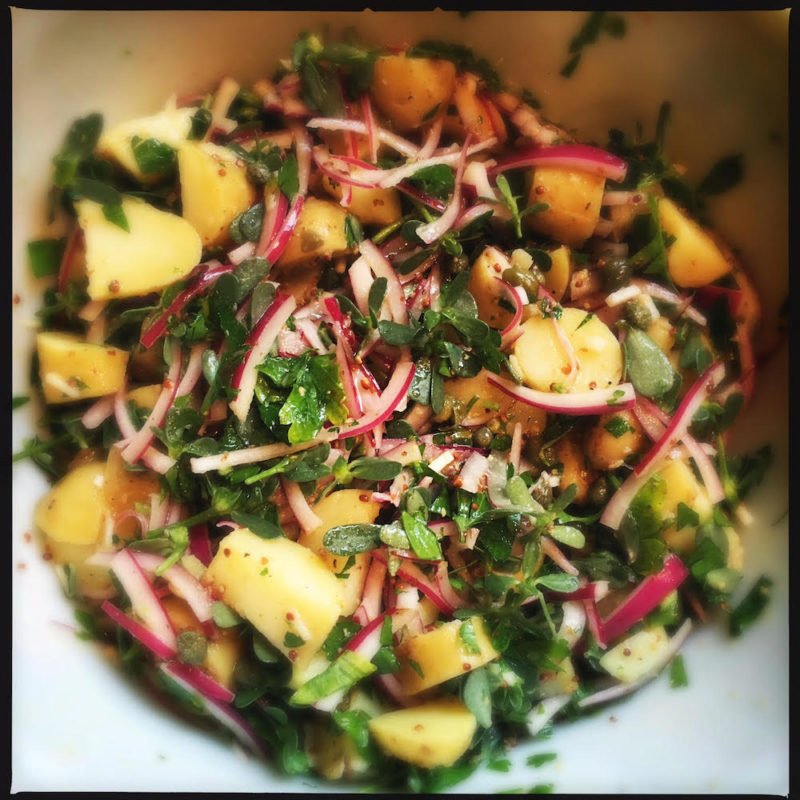
Before I get to this delicious Potato Purslane Salad recipe, I want to provide a little commentary on last week’s news that eating potatoes increased the risk of developing high blood pressure. Whenever I see a headline-grabbing nutrition story such as this one, I make sure I find and read the original research paper to see what’s what.
So I did, and based on what I read, I would certainly say that if you eat more than four servings per week of mashed/baked/boiled white potatoes and/or French fries, you may want to reconsider the wisdom of that. What is it about eating potatoes frequently that could contribute to higher blood pressure? It’s not weight gain due to excess calories (researchers considered that, but it turned out not to make a difference). It may be that potatoes, especially white potatoes, have a high glycemic load (i.e., they increase your blood sugar more than many other foods). White potatoes are basically your standard russet potatoes, used ubiquitously with both baked potatoes and French fries, but certainly they are often served mashed and boiled as well.
A better way to eat potatoes
I rarely if ever eat russets, other than when I occasionally have French fries, which is really what they’ve been bred for. When we do have potatoes, which is may be once a week on average, we go for roasted new potatoes (new potatoes have a lower glycemic load), or we cook and cool the potatoes to use in salads. When you cook and cool potatoes, their starch molecules align themselves in a way that makes them resistant to digestion (except by the good bacteria in your intestines!), which means they don’t affect your blood sugar levels as much when you eat them (if you’ve heard that “resistant starch” is good for you, that’s what this is referring to).
- Other factors that reduce the glycemic load of potatoes includes
- Eating the skins (a good reason to buy organic)
- Opting for waxy potatoes instead of starchy
- Eating them with fiber-rich foods (such as non-starchy veggies), protein or other low glycemic load foods
- Adding healthy fat and some sort of acid (vinegar, lemon juice)
This recipe hits all of those marks. It keeps the skins on, uses waxy fingerling potatoes, contains purslane (a leafy green rich in plant-based omega-3 fatty acids), olive oil and lemon juice, and I recommend eating it as one component of a meal with protein and some other non-starchy vegetables (such as a green salad). And, the potatoes were cooled for a day before making the salad.
As for the purslane, it’s my new green love. Alas, it’s hard to find (which is why you can substitute arugula). I bought a bunch of purslane at the Santa Monica Farmer’s Market, but I think it’s a bit early to find it at Seattle farmers markets (haven’t had a chance). I have seeds to grow the weed tasty green, but it’s a perennial, so I won’t get a good harvest until next year. The leaves are mild but the stems can be a bit bitter, which is why the recipe calls for just the plucked leaves. For more ideas of what to do with purslane, Clotilde at Chocolate & Zucchini offers 45 more!
Potato-Purslane Salad
Ingredients
- 1 pound fingerling potatoes, washed or gently scrubbed
- 1/3 cup extra virgin olive oil
- 2 tablespoons white wine vinegar
- Juice of 1/2 lemon
- 1 teaspoon Dijon mustard
- 1 garlic clove, minced
- 1/2 teaspoon sea salt
- 1/2 teaspoon freshly ground pepper
- 1 medium red onion, thinly sliced
- 1 cup purslane leaves (can substitute arugula)
- 1/2 cup chopped parsley
- 1/2 cup chopped mint
- 1/4 cup capers
- More salt and pepper to taste
Directions
- Cut potatoes in half (or into quarters if they are long). Aim to have the pieces be bite-size. Place the potatoes or potato chunks in a medium-sized pot. Cover the potatoes with an inch of water and stir in a teaspoon of salt.
- Bring the water to a simmer over medium-high heat, then adjust the heat as needed to keep the water at a gentle simmer. Cook until the potatoes are tender all the way through when pierced with a fork, about 8 to 12 minutes. (Exact cooking time will depend on the type of potato and the size of your cubes.)
- Drain the potatoes and rinse them under cool water. Transfer them to a mixing bowl and place into the refrigerator until chilled. Once chilled, slice the red onion and add to the potatoes.
- To make the vinaigrette, whisk together the olive oil, vinegar, lemon juice, minced garlic and salt and pepper in a small bowl or Pyrex measuring cup.
- Slice the onion and pluck the purslane leaves from the stems (or tear up the arugula into small pieces). Chop the herbs.
- Add the onions to the potatoes and pour the vinaigrette over the mixture. Stir gently to combine. Add the purslane or kale, the herbs and the capers. Gently stir again. Add more salt and pepper if needed.
- Allow the salad to sit in the refrigerator for an hour or more for the flavors to meld.






